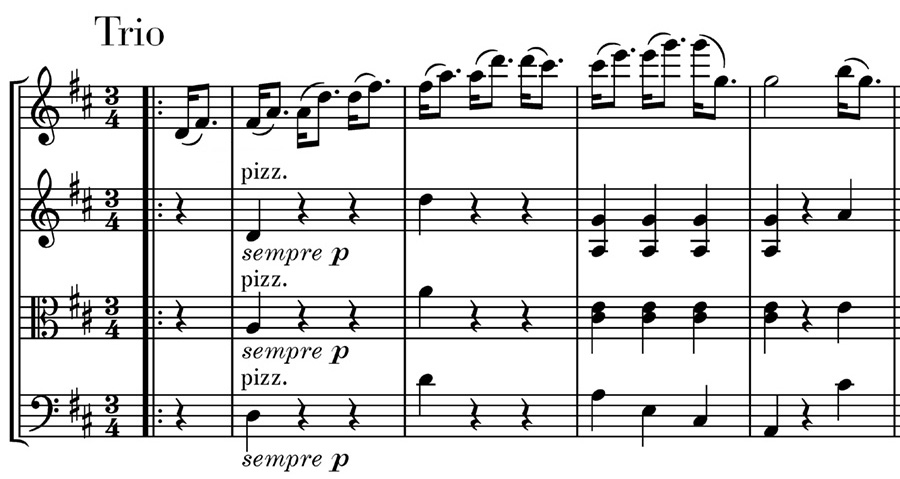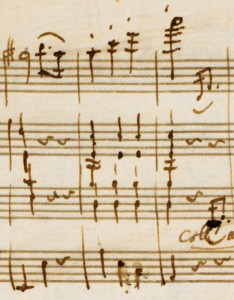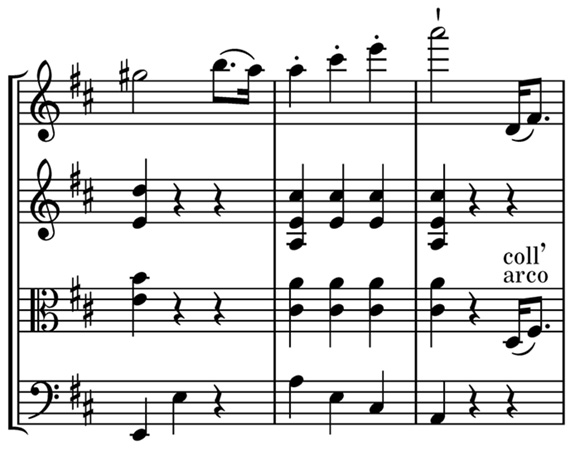The exceptionally lighthearted D-major Trio of the Menuetto in Mozart’s otherwise so darkly dramatic d-minor String Quartet K. 421 has always been one of my favourite pieces. The first violin, with its “pizzicato” accompaniment by the lower strings, cleverly plays there with reminiscences of folk music: on the one hand, it is quite obviously striking up a yodel, recognisable by the simple triadic melodicism flipping repeatedly from “chest” to “head” voice, just like a real alpine yodler; on the other, the entire movement is almost prototypically pervaded by the so-called “lombardic” rhythm, unmistakeable signs, for instance, of Scottish, Hungarian or Slavic folk music (recognisable in the inverse-dotted, syncopated rhythm):
Let’s listen to the short piece in the Jerusalem String Quartet’s magnificent performance:
K. 421,Trio, Jerusalem String Quartet
As most Henle blog readers already know, I am currently working on Urtext editions of all the Mozart string quartets. Volume IV has already appeared, volume III with the six quartets dedicated to Haydn is appearing next year (2018). That’s where we’ll also find our little trio. And just this trio includes a small editing problem, not at all so easy to solve. Here it is, briefly – and I’d be greatly interested in hearing your opinion about it: that is, one time only in his autograph manuscript, in measure 14, Mozart does not notate the movement in the “lombardic”, but in the “normal” dotted rhythm:
A writing error? Possibly, for even a Mozart can occasionally make a slip of the pen. And in a sense, making the matter more difficult is that in the first edition just this spot is engraved and printed as expected, that is, in lombardic rhythm.
This first edition was published in 1785 by the Viennese publishers Artaria, virtually right under Mozart’s nose, and is in this respect of prime importance as a source. However, by virtue of the fact that the printed score does indeed include much done hastily and imprecisely, even to additions (especially dynamic markings) going beyond the autograph at numerous spots, these additions and corrections are so striking that they can only go back to Mozart himself. So, it is clear that in the parts material copied from the original autograph score, he refined and corrected his text. Mozart’s private performances of the “Haydn Quartets” are documented in his correspondence. The parts material that he corrected, to then serve the music engraver as engraver’s model, is of course lost.
All of the many printed editions from the 19th century up until about the middle of the 20th century are based on this first edition. Our spot in question is – of course – always in the lombardic rhythm. Numerous recordings from the period up to about 1960 document this problematic reading, since most string quartets of the early 20th century played from the Edition Peters, much used then, but now without value because its text is not that of a critical edition. Here is an example by the heroes of my youth, the Juilliard Quartet:
K. 421,Trio, Juilliard Quartet
Until Alfred Einstein came and produced the 10 “famous” Mozart string quartets, critically edited for the first time according to modern methods (published in 1945 by Novello publishers). A turning point in the history of this edition, for Einstein was able to expose and rectify innumerable traditional errors in this work, as well as also in the d-minor quartet, through meticulous comparison with the autograph. He takes the K. 421 trio passage from the autograph without any commentary. Ludwig Finscher’s source- and text-critical editorial work for the New Mozart Edition (NMA, 1962), and the Bärenreiter parts material are based on Einstein’s edition (taking over Einstein’s correct decisions, but unfortunately also many of his errors). At our spot, this edition reproduces the autograph reading, not that of the first-edition, thus not the lombardic rhythm, but:
There are no string quartets known to me that would not follow this text today. Yet which version is the correct one, that is, which did Mozart want? Both sources, autograph as well as first edition, rank as primary. A virtually insoluble conflict. Certainly, Mozart’s autograph is clear, and the first-edition’s engraver (or the copyist of the engraver’s model, now lost, on which this edition is based) could also have made a slip of the pen. But just the same, Mozart also could still have corrected this little passage before publication.
I am not certain what to edit in the main text. Personally, I like the autograph version better – and I could also give a musico-stylistic reason for that. But editing is indeed not a matter of taste. Shouldn’t I most likely comment on this spot in the critical report and/or perhaps even give the respective alternative reading as an “ossia” footnote? But what do you think, string-quartet players and Mozart fans amongst our blog readers? What arguments can you contribute? I am keen to know and grateful for your interest!





It’s a great question, and I certainly see the argument for both.
I’m not a Mozart expert, but to me, the different rhythm in the original autograph seems particularly deliberate; if this rhythmic inconsistency appeared earlier in this passage, it would ring out as more of a possible copying error to me. But it occurs right at the resolution point to the phrase end; the net effect functions ornamentally to “hold back” the 3 quarter notes that follow it, giving a little pause leading us to the final notes of the phrase. However it is labeled, this little variant rhythm does seem to serve a musical purpose.
It is certainly possible that after writing out the lombardic rhythm a couple of dozen times preceding this, something could have captured Mozart’s attention and caused a little slip of the pen. If the composer had deliberately decided to create a variation at this spot but with two 8th notes, rather than the dotted 8th, 16th. Then, of course, the argument would easily be made that the 16th beam and the dot were left off unintentionally, and we might be having a different discussion. But, I’m inclined to think what is in the autograph is intentional in this case.
…If a rhythmically identical passage were to occur elsewhere in the piece with this same beat leading to the phrase end written in lombardic rhythm, this would be an additional consideration, of course.
Thanks for this thought-provoking article.
rp
I believe that the autograph is correct for the following reason (the reader will need to look at the entire phrase in the score to understand the reasoning):
The high F# in violin 1 in m. 12 leads to the high D in m. 13 and finally to the B in measure 14 to complete the motion to the A in m. 15. The G# in m. 14, which also resolves to the A in m. 15 is a comical “wrong turn” that delays the arrival of the B. Since the B is actually the more important tone, it needs greater length than a mere sixteenth would have given it, and thus Mozart reversed the rhythm to make it a dotted eighth.
This change of rhythm then motivates a change of rhythm in the melody of 15-16 to straight quarters. The combination of the normal dotted eighth and sixteenth followed by the quarter notes stands out in the middle of the trio as another comic effect: as if some county musicians are suddenly corrected by some “proper” court musicians.
Musical analysis can play a crucial role in textual problems of this type.
I assume this problem has long since been resolved, but just to add one more argument for the autograph reading: It cannot be “a” slip of the pen, it would have to be *two* slips of the pen, since both the dot lengthening the quaver and the slash creating the semiquaver have to be written separately from the noteheads, stem, and beam. I suppose one could still hypothesize that Mozart had a slip of the mind, but it seems beyond question that at the moment of writing, he imagined the exceptional (non-Lombard) rhythm that he wrote. (I also think the exception makes sense because it is a classic supertonic resolution at a point where M exits the Lombard pattern in any case for the A major arpeggio. At the corresponding cadence in D major, the Lombard pattern continues on the final tonic.)
I think the copyist made the error of the first version. The normal dotted rhythm musically makes sense in measure 14 since it the following two measure are not in Lombardic rhythm either. So it (at least to me or to whoever studied or played this quartet) looks like dotted rhythm is logically there for a certain purpose; the porpse of intrudcing a totally new rhythm for the ending of the previous Lombardic phrase.
Ali Saniee Nia
Agreed, Ali.
In case anyone following this blog discussion is curious, have a look here for another interpretive question in this movement:
https://www.teatronuovo.org/record-of-the-week-2/strings-attached